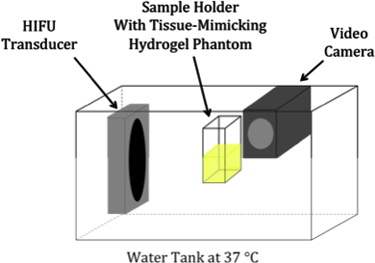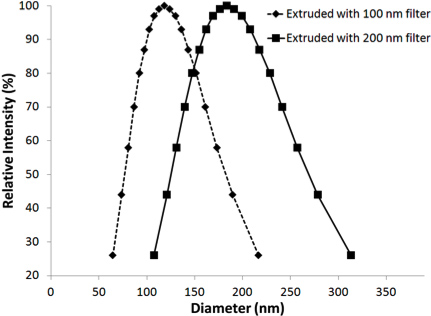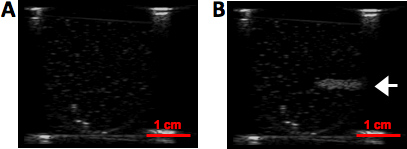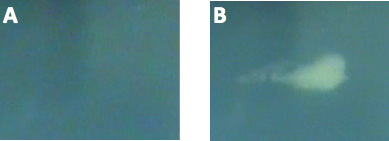A subscription to JoVE is required to view this content. Sign in or start your free trial.
Method Article
Synthesis of Phase-shift Nanoemulsions with Narrow Size Distributions for Acoustic Droplet Vaporization and Bubble-enhanced Ultrasound-mediated Ablation
In This Article
Summary
Phase-shift nanoemulsions (PSNE) can be vaporized using high intensity focused ultrasound to enhance localized heating and improve thermal ablation in tumors. In this report, the preparation of stable PSNE with a narrow size distribution is described. Furthermore, the impact of vaporized PSNE on ultrasound-mediated ablation is demonstrated in tissue-mimicking phantoms.
Abstract
High-intensity focused ultrasound (HIFU) is used clinically to thermally ablate tumors. To enhance localized heating and improve thermal ablation in tumors, lipid-coated perfluorocarbon droplets have been developed which can be vaporized by HIFU. The vasculature in many tumors is abnormally leaky due to their rapid growth, and nanoparticles are able to penetrate the fenestrations and passively accumulate within tumors. Thus, controlling the size of the droplets can result in better accumulation within tumors. In this report, the preparation of stable droplets in a phase-shift nanoemulsion (PSNE) with a narrow size distribution is described. PSNE were synthesized by sonicating a lipid solution in the presence of liquid perfluorocarbon. A narrow size distribution was obtained by extruding the PSNE multiple times using filters with pore sizes of 100 or 200 nm. The size distribution was measured over a 7-day period using dynamic light scattering. Polyacrylamide hydrogels containing PSNE were prepared for in vitro experiments. PSNE droplets in the hydrogels were vaporized with ultrasound and the resulting bubbles enhanced localized heating. Vaporized PSNE enables more rapid heating and also reduces the ultrasound intensity needed for thermal ablation. Thus, PSNE is expected to enhance thermal ablation in tumors, potentially improving therapeutic outcomes of HIFU-mediated thermal ablation treatments.
Protocol
1. Preparation of Phase-shift Nanoemulsion (PSNE)
- Dissolve 11 mg DPPC and 1.68 mg DSPE-PEG2000 in chloroform
- Evaporate the organic solvent to form a dry lipid film in a glass round-bottom flask
- Dessicate the lipid film overnight
- Rehydrate the lipid film with 5.5 ml of phosphate-buffered saline (PBS)
- Heat solution in a 45 °C water bath until lipid film dissolves, vortexing periodically
- Transfer lipid solution into 7 ml vial
- Sonicate lipid solution for 2 min at 20% amplitude
- Divide solution into two vials of 2.5 ml each (discard remaining 0.5 ml)
- Add 2.5 ml PBS to each vial
- Place each vial in a 0 °C ice-water bath
- Add 50 μl DDFP to each vial
- Sonicate each vial in the ice-water bath using the following settings: 25% amplitude, pulsed mode (10 sec on, 50 sec off), 60 sec total on time
- Transfer PSNE solutions to 20 ml scintillation vials
- Add 5 ml PBS to each vial, resulting in 10 ml final volume
- Assemble extruder following directions provided by manufacturer
- Rinse each part with deionized water
- Place the stainless steel support disc in the center of the filter support base
- Place the stainless steel mesh on top of the stainless steel support disc
- Using tweezers, place an extruder drain disc membrane (shiny side up) on the stainless steel mesh
- Using tweezers, place the extruder filter (shiny side up) on the drain disc membrane
- Carefully place the small O-ring on the filter and place the thermobarrel and extruder top above the support base
- Partially tighten each wing-nut first, then completely tighten the wing-nuts by hand in an alternating fashion
- Connect the extruder to a nitrogen gas line
- To prime the extruder, pipette 10 ml deionized water into the top sample port, cap the opening, and tighten the vent valve
- Slowly open the nitrogen gas line to increase the pressure, forcing the sample through the membranes, and collect the sample from the outlet tubing
- After use, disassemble in reverse order, rinse the extruder parts with deionized water, and discard the membrane filter and membrane drain disc
- For 100 nm droplets only, pre-condition PSNE by extruding 10 times through 200 nm filter
- Extrude PSNE 16 times through 100 nm or 200 nm filter to obtain narrow size distribution
2. Preparation of Polyacrylamide Hydrogel Containing PSNE
- Prepare 24% BSA solution by diluting 1.2 g BSA powder in 5 ml deionized water
- Prepare 10% APS solution by diluted 0.1 g APS powder in 1 ml deionized water
- In the following order, mix 2.1 ml acrylamide solution, 1.2 ml Tris buffer, 0.1 ml 10% APS, 4.5 ml 24% BSA solution, and 3.6 ml deionized water in plastic chamber
- Heat to 40 °C and place under vacuum for 1 hr
- Add 480 μl of PSNE and thoroughly mix by gently swirling the plastic chamber.
- Add 12 μl TEMED and place the chamber in a 12 °C water bath for 2 hr
3. Representative Results
A schematic of the setup for ultrasound experiments with tissue-mimicking hydrogel phantoms is shown in Figure 1. This protocol results in lipid-coated perfluorocarbon droplets with a narrow size distribution that are stable in solution for at least a week. The size distribution measured with dynamic light scattering (90Plus Particle Size Analyzer, Brookhaven Instruments, Holtsville, NY) is shown in Figure 2 for PSNE extruded using 100 and 200 nm filters. The PSNE effective diameter over time, measured using dynamic light scattering, is listed in Table 1, demonstrating that PSNE are stable for at least a week. B-mode images of PSNE before and after vaporization in a polyacrylamide hydrogel are shown in Figure 3. Also, a lesion formed by 15 sec of HIFU-mediated heating in a polyacrylamide hydrogel containing albumin and PSNE is shown in Figure 4. The asymmetric shape of the lesion is a result of prefocal heating that occurs due to the presence of the bubble cloud in the ultrasound path. It is important to note that prefocal heating and lesion formation due to scatter from bubbles can be minimized by reducing the transmitted acoustic power.

Figure 1. Schematic diagram of experimental setup for ultrasound experiments with tissue-mimicking hydrogels.

Figure 2. Size distribution of PSNE extruded through 100 nm or 200 nm filters, measured using dynamic light scattering. The units of the ordinate axes are based on the intensity of scattered light from particles of a certain size relative to the total scattered light intensity from the sample.

Figure 3. B-mode images (a) before and (b) after PSNE vaporization in a polyacrylamide hydrogel. The arrow indicates the focal region where a bubble cloud was formed by PSNE vaporization.

Figure 4. Images of polyacrylamide hydrogel containing albumin and PSNE (a) before and (b) after vaporization and sonication with HIFU, demonstrating lesion formation as a result of ultrasound-induced heating. The ultrasound center frequency was 3.3 MHz. The ultrasound signal consisted of an initial 30-cycle, 6.4 W pulse to vaporize PSNE, immediately followed by 15 sec of continuous ultrasound at 0.77 W.
| Days after extrusion | Extruded with 200 nm filter | Extruded with 100 nm filter | ||
| Mean Dia. (nm) | Std. Dev. (nm) | Mean Dia. (nm) | Std. Dev. (nm) | |
| 1 | 182.9 | 4.9 | 118.0 | 0.9 |
| 7 | 177.7 | 2.5 | 124.8 | 3.1 |
Table 1. Mean diameter and standard deviation of PSNE at one and seven days after extrusion with 100 nm and 200 nm filters.
Discussion
High-intensity focused ultrasound (HIFU) is used clinically to thermally ablate tumors.1 To enhance localized heating and improve thermal ablation in tumors, lipid-coated perfluorocarbon droplets have been developed which can be vaporized by HIFU. The vasculature in many tumors is abnormally leaky due to their rapid growth.2 Thus, nanoparticles are able to penetrate the fenestrations and passively accumulate within tumors, a process known as the enhanced permeability and retention (EPR) effect...
Disclosures
No conflicts of interest declared.
Acknowledgements
This work was supported by a BU/CIMIT Applied Healthcare Engineering Predoctoral Fellowship, a National Science Foundation Broadening Participation Research Initiation Grant in Engineering (BRIGE), and the National Institutes of Health (R21EB0094930).
Materials
| Name | Company | Catalog Number | Comments |
| DPPC | Avanti Lipids, Alabaster, AL, USA | 850355P | 1,2-dipalmitoyl-sn-glycero-3-phosphocholine |
| DSPE-PEG2000 | Avanti Lipids, Alabaster, AL, USA | 880120P | 1,2-distearoyl-sn-glycero-3-phosph–thanolamine-N-[methoxy(polyethylene glycol)-2000] (ammonium salt) |
| DDFP | Fluoromed, Round Rock, TX, USA | CAS: 138495-42-8 | Dodecafluoropentane (C5F12) |
| PBS | Sigma-Aldrich, St. Louis, MO, USA | P2194 | Phosphate-buffered saline |
| Chloroform | Sigma-Aldrich, St. Louis, MO, USA | 372978 | Chloroform |
| Acrylamide | Sigma-Aldrich, St. Louis, MO, USA | A9926 | 40% 19:1 acrylamide/bis-acrylamide |
| Tris buffer | Sigma-Aldrich, St. Louis, MO, USA | T2694 | 1M, pH 8, trizma hydrochloride and trizma base |
| BSA | Sigma-Aldrich, St. Louis, MO, USA | A3059 | Bovine serum albumin |
| APS | Sigma-Aldrich, St. Louis, MO, USA | A3678 | Ammonium persulfate solution |
| TEMED | Sigma-Aldrich, St. Louis, MO, USA | 87689 | N,N,N',N'-Tetramethylethylenediamine |
| Equipment | |||
| Sonicator (3 mm tip) | Sonics Materials, Inc., Newtown, CT, USA | Vibra-Cell | |
| Water bath | Thermo Fisher Scientific, Waltham, MA, USA | Neslab EX-7 | |
| Extruder | Northern Lipids, Burnaby, BC, Canada | LIPEX | |
| Extruder Filters | Whatman, Piscataway, NJ, USA | Nuclepore #110605 and #110606 | |
| Extruder Drain Disc | Sterlitech Corporation, Kent, WA, USA | #PETEDD25100 | |
| Plastic chamber | U.S. Plastic Corporation, Lima, OH, USA | #55288, 1 3/16"x1 3/16"x2 7/16" | |
References
- Hynynen, K., Darkazanli, A., Unger, E., Schenck, J. F. MRI-guided noninvasive ultrasound surgery. Med. Phys. 20, 107-115 (1993).
- Baban, D. F., Seymour, L. W. Control of tumour vascular permeability. Adv. Drug Deliv. Rev. 34, 109-119 (1998).
- Maeda, H., Wu, J., Sawa, T., Matsumura, Y., Hori, K. Tumor vascular permeability and the EPR effect in macromolecular therapeutics: a review. J. Control. Release. 65, 271-284 (2000).
- Schadlich, A. Tumor accumulation of NIR fluorescent PEG-PLA nanoparticles: impact of particle size and human xenograft tumor model. ACS Nano. 5, 8710-8720 (2011).
- Williams, R. Convertible perfluorocarbon droplets for cancer detection and therapy. 2010 IEEE Ultrasonics Symposium. , (2010).
- Martz, T. D., Sheeran, P. S., Bardin, D., Lee, A. P., Dayton, P. A. Precision manufacture of phase-change perfluorocarbon droplets using microfluidics. Ultrasound Med. Biol. 37, 1952-1957 (2011).
- Giesecke, T., Hynynen, K. Ultrasound-mediated cavitation thresholds of liquid perfluorocarbon droplets in vitro. Ultrasound Med. Biol. 29, 1359-1365 (2003).
- Sheeran, P. S., Luois, S., Dayton, P. A., Matsunaga, T. O. Formulation and Acoustic Studies of a New Phase-Shift Agent for Diagnostic and Therapeutic Ultrasound. Langmuir. 27, 10412-10420 (2011).
- Sheeran, P. S. Decafluorobutane as a phase-change contrast agent for low-energy extravascular ultrasonic imaging. Ultrasound Med. Biol. 37, 1518-1530 (2011).
- Zhang, P. . The Application of Phase-Shift Nanoemulsion in High Intensity Focused Ultrasound: An In Vitro Study [Doctoral Dissertation]. , (2011).
- Allen, T. M., Hansen, C., Martin, F., Redemann, C., Yau-Young, A. Liposomes containing synthetic lipid derivatives of poly(ethylene glycol) show prolonged circulation half-lives in vivo. Biochim. Biophys. Acta. 1066, 29-36 (1991).
- Klibanov, A. L., Maruyama, K., Beckerleg, A. M., Torchilin, V. P., Huang, L. Activity of amphipathic poly(ethylene glycol) 5000 to prolong the circulation time of liposomes depends on the liposome size and is unfavorable for immunoliposome binding to target. Biochim. Biophys. Acta. 1062, 142-148 (1991).
- Klibanov, A. L., Maryama, K., Torchilin, V. P., Huang, L. Amphipathic polyethyleneglycols effectively prolong the circulation time of liposomes. FEBS Lett. 268, 235-237 (1990).
- Gabizon, A. Prolonged circulation time and enhanced accumulation in malignant exudates of Doxorubicin encapsulated in polyethylene-glycol coated liposomes. Cancer Res. 54, 987-992 (1994).
- Awasthi, V. D., Garcia, D., Goins, B. A., Philips, W. T. Circulation and biodistribution profiles of long-circulating PEG-liposomes of various sizes in rabbits. Int. J. Pharm. 253, 121-132 (2003).
- Zhang, P., Porter, T. An in vitro study of a phase-shift nanoemulsion: a potential nucleation agent for bubble-enhanced HIFU tumor ablation. Ultrasound Med. Biol. 36, 1856-1866 (2010).
- Lafon, C. Gel phantom for use in high-intensity focused ultrasound dosimetry. Ultrasound Med. Biol. 31, 1383-1389 (2005).
Reprints and Permissions
Request permission to reuse the text or figures of this JoVE article
Request PermissionExplore More Articles
This article has been published
Video Coming Soon
Copyright © 2025 MyJoVE Corporation. All rights reserved